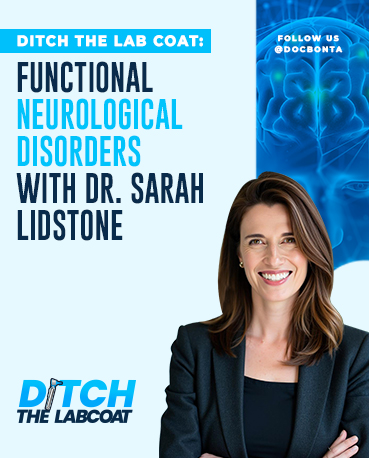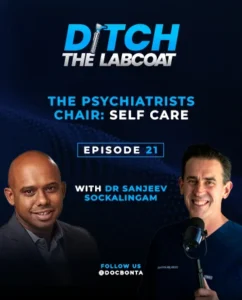Let’s face it: us physicians love a good, old-fashioned diagnosis. When we see a patient who comes in with chest pain, shortness of breath, and an EKG that looks like the scariest mountain range you’ve ever seen, we know exactly what to do. It’s a heart attack! Even a medical student can make that slam dunk diagnosis early in their training. But what about when someone rolls into the ER at 3 a.m. with shaking limbs and numbness all over, a bit of a headache that comes and goes, blurred vision that is tough to describe and burning and their feet? Especially when the MRI and blood work come back as pristine as a new scalpel. That’s when things get… complicated.
This is the gray, foggy realm of Functional Neurological Disorders (FND). And in the latest episode of the Ditch the Lab Coat podcast, I had the pleasure of diving into this medical enigma with Dr. Sarah Lidstone, an expert in neurology who’s been on the frontlines of treating and understanding FND.
https://deptmedicine.utoronto.ca/news/new-model-care-patients-movement-disorders
So, What Exactly is FND?
If you’re thinking, “Wait, are we talking about something real here or is this just a case of ‘it’s all in their head?’”—you’re not alone. That’s precisely the misconception we addressed during our chat.
As Dr. Lidstone so aptly put it, there are two ways to get a neurological symptom. You can either have:
- Structural damage (like a stroke or a tumor).
- Functional disruption (the brain’s communication networks are on the fritz, but structurally everything looks fine).
FND falls into the latter category. Imagine your brain as the world’s most sophisticated supercomputer. In FND, the hardware is working just fine, but the software has developed some bugs. It’s like when your computer freezes up for no reason—sure, you could try kicking it (we’ve all been there), but really, you need a techie to debug the software.
https://www.ninds.nih.gov/health-information/disorders/functional-neurologic-disorder
The Case That Stumped Me
During my residency, I had a middle-of-the-night encounter with a patient in their twenties who suddenly couldn’t move her leg. By morning, she couldn’t move her arms either, and before I knew it, she was shaking so violently that we called a Code Blue. I pushed medications, updated the family, and tried everything in my toolkit, but the senior ER doc walked in and casually said, “Just ignore it. It’ll stop.”
And you know what? It did.
Turns out, it wasn’t a seizure in the traditional sense—it was a classic presentation of FND. But there I was, a clueless resident, surrounded by dismissive shrugs from senior doctors who were more interested in lunch breaks than learning how to treat something that didn’t show up on a CAT scan. That’s when I realized there was a *huge* gap in how we handle these patients. Functional seizures are much more common than those rare ‘zebras’ we hunt for in medicine. And it is certainly worth learning how to recognize them and treat them – something that we really unpackaged in the pod today.
The “Whack-a-Mole” of Neurological Symptoms
One of the hallmarks of FND, as Dr. Lidstone explained, is its shape-shifting nature. Today, it’s a tremor in the right hand; tomorrow, it’s numbness in the left foot. The symptoms are inconsistent, they wax and wane, and they often defy the traditional neurological rule of “where is the lesion?”
But here’s the thing: FND is *not* a diagnosis of exclusion. In other words, it’s not something we label a patient with just because all their other tests came back negative. There are specific signs—like the Hoover’s Sign—that neurologists can use to positively identify FND. It’s a game-changer in making patients feel validated instead of dismissed as “fakers.”
https://www.vjneurology.com/video/zgnh8cm_hhw-diagnosing-functional-movement-disorder/
Society’s Love-Hate Relationship with Invisible Illness
Dr. Lidstone didn’t shy away from calling out the long history of misogyny in medicine when it comes to these so-called “invisible illnesses.” Back in the 1800s, women with similar symptoms were labeled as “hysterical”—a diagnosis with all the scientific rigor of a witch trial.
But things haven’t changed as much as we’d like to think. Even today, patients with FND often face skepticism from doctors, family, and society. “If only you had an abnormal MRI,” I joked, “then everyone would believe you!” But therein lies the challenge: how do you explain to a patient (and their frustrated family) that their very real symptoms don’t show up on any scan?
Why “Treatment” is the Wrong Word
Dr. Lidstone threw me a curveball when she corrected my old-school terminology. “We don’t call it treatment anymore; we call it therapy,” she said. Because unlike a bacterial infection where you throw antibiotics at it, FND requires a much more nuanced, patient-driven approach.
It turns out, therapy for FND involves everything from Cognitive Behavioral Therapy (CBT) to physiotherapy aimed at retraining the brain’s motor pathways. But here’s the kicker: only about 40% of patients are even ready for therapy when they first walk into her clinic. It’s not because they don’t want to get better—it’s just that, sometimes, the brain is still stuck in its own glitchy software loop.
Prognosis: Can You Actually Get Better?
Dr. Lidstone was refreshingly optimistic but realistic. For patients who engage in therapy, the outlook can be surprisingly good. They may not be cured in the traditional sense, but they can learn to manage their symptoms, recognize triggers, and get on with their lives.
But let’s be real: FND is no walk in the park. There’s no magic pill. Patients need to be active participants in their recovery, which is why Dr. Lidstone’s clinic focuses on empowering patients rather than just throwing prescriptions at them. In her words, it’s all about agency—the belief that you have some control over your symptoms.
https://integrated-move.mykajabi.com/connect
Final Thoughts: Don’t Be Weird
Dr. John Stone, a pioneer in FND, has a favorite mantra: “Don’t be weird.” Whether it’s diagnosing a heart attack or a functional seizure, the recipe is the same. Listen to your patient, take a good history, do a thorough exam, and communicate clearly. The only difference with FND? You’re diagnosing a software glitch, not a hardware failure.
So, the next time you see a patient whose symptoms don’t fit neatly into a textbook, remember: it’s not about what the tests say. It’s about what the patient is saying.



